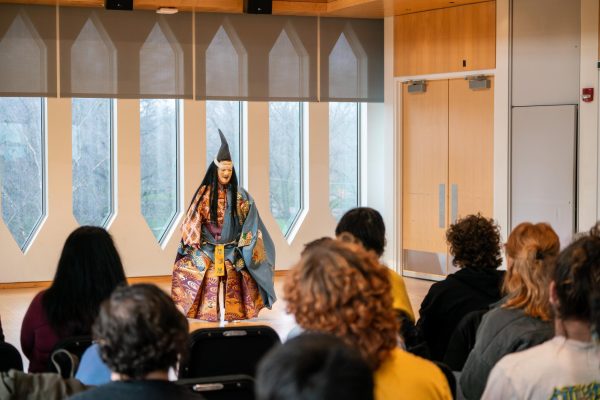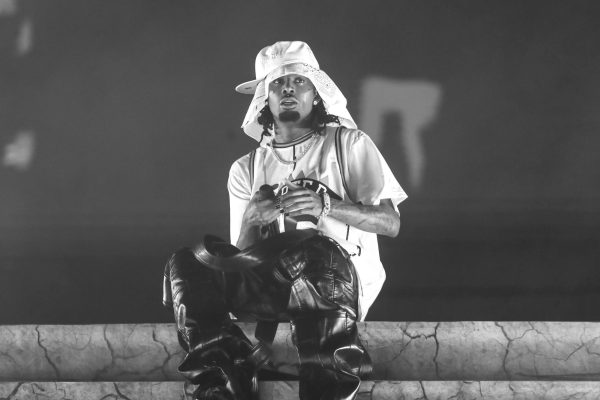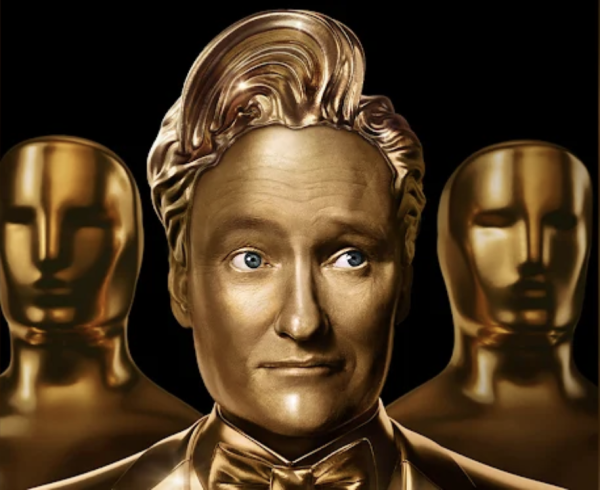Franz, Osborn Direct Riveting, Dynamic Production of Ives’ “Venus in Fur”
College sophomore Meg Franz made a landmark directorial debut alongside senior Will Osborn Friday night with a lean, sharp, riveting production of Venus in Fur.
The script, by contemporary playwright David Ives, features Thomas Novachek (Osborn), a working playwright trying to direct his own adaptation of Venus in Furs, the infamous 1870 sadomasochistic novel by Austrian author Leopold von Sacher-Masoch. As Novacheck begins staging his own piece, he enters into a strange and increasingly unsettling dynamic with Vanda Jordan (College sophomore Samantha Brooks), an actress on the opposite side of Novachek’s casting table. At first, Jordan appears to be the crystallization of Novachek’s impression of a modern actress: shallow, graceless, and empty-headed. But as Jordan — uncannily, also named Vanda — proves to be an almost perfect fit for the part she begins to take a visceral power over Novachek, which she uses to push back both against the play-within-a-play and against its author. These strange and mesmerizing interactions are fueled by the thematic content of the piece: lust, control, masculine and feminine dominance, and the possibilities of love. The play raises the question: Is the male novelist’s conception of love and sexuality, filtered through the lens of BDSM, an expression of pure human truth? Or is it a projected patriarchal power play?
Venus in Fur would be a challenge for any creative team, let alone one helmed by a first-time director operating on a bare-bones budget in a classroom space, but Oberlin’s production meets those challenges expertly, keeping the audience’s focus on Novachek’s and Jordan’s strange and spontaneous relationship. Throughout the play, Brooks played Jordan with fluidity, moving from ingratiation to seduction to domination to burning conflict at the drop of a hat. Osborn, on the other hand, played Novachek as frustrated, enraptured, lustful, and enraged in turn. This contrast flips well-worn scripts about gendered power dynamics — in this play, Jordan is the more active character, while Novachek is the more emotional one. Within the narrative of the play, Jordan must be the driving force of the production, even while presenting outward passivity, and Novachek must ultimately be a receptacle for Jordan’s actions.
In this production, Brooks delivered a powerhouse performance as Vanda Jordan. While her background in dance and burlesque has clearly given her a strong bedrock of physical control — readily apparent on stage — it would be a grave understatement of her accomplishment in Venus in Fur to neglect the stage presence she’s built through her acting craft. Throughout most of the play, Jordan has to hold on to three or more layers of deception while following a strong internal drive, requiring a remarkable clarity of purpose and a subtle awareness of the play’s circumstances throughout. Brooks accomplished this consistently throughout the show’s 90-minute runtime. Even when she’s playing the fool, Jordan is clearly a powerful force and maybe a menace, and this fact is clear to the audience even while Novachek is fooled by Jordan’s feigned ignorance.
Osborn’s performance, while less flashy, was equally layered. The voyeurism and craving for control that drives Novachek needs to be almost opaquely obfuscated by his own professed literary values. Osborn’s performance strained credibility in the first scenes of the show, but quickly steadied the course, building a charming fortress of artistic propriety to be knocked down in the third act. If there was any significant weakness in his performance, it was one of texture, and the challenge of a young actor embodying a convincing suite of vocal and physical patterns for a working writer in his 30s or older. This is all, however, ancillary to Thomas’s character progression, and Osborn painted his drives and desires compellingly enough that problems of mannerism felt quite minor.
The net result of the collaboration between Franz, Osborn, and Brooks is entrancing. The show is thoughtful, laugh-out-loud funny, sexy, harrowing, and engrossing throughout. Bolstered by some deft lighting work designed and installed by Osborn and operated by Meg and a sparse but affecting soundscape of thunderclaps by sophomore Celeste Debardelaben, Venus in Fur is a tour de force, deserving of a more extensive production in a more flexible space — Warner Studio 2 is somewhat cramped, with support poles in a few awkward areas. The trio behind this production are absolutely worth following, and I’m excited to see what each of them produces next.









